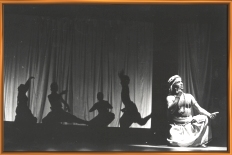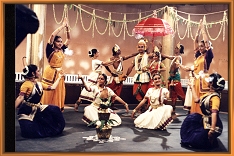

GROUP PRODUCTIONS
SRI THYAAGARAAJA VAIBHAVAM (1992)
Sri Thyaagaraaja Vaibhavam is a theme conceived by S Viswanathan of Kalamandir Trust and presented first time for the fund collection of the Thyaagaraaja Vidwat-Samajam on June 21, 1992 at the Music Academy, Chennai.It was the rendering of nannuvidachi by M D Ramanathan that inspired Dhananjayan to produce a dance drama on Thyaagaraaja. It does not study the life of the poet but delves into his mind, his detached attitude towards life and his obsession with the metaphysical. Thyaagaraaja krithis were never considered great favourites in Bharatanatyam as their concentration on bhakti and lack of shringara bhava discouraged dancers from exploring their potential as dance music. Thyaagaraaja Vaibhavam however succeeds in portraying bhakti as the highest form of shringara. It was Rukmini Devi who started including Thyaagaraaja’s songs in her recitals and received brickbats for eschewing sringara in dance.
Sri Thyaagaraaja Vaibhavam is about 2 hours long and has been performed more than 22 times. It was broadcast on television and as a result, lost out on its theatre value of live performance.
Synopsis
Tiruvarur is an ancient kshetra on the banks of the Cauvery River, renowned for its saints, traditions and musicians. Saint Thyaagaraaja was born here into a Telugu Vaidika family in the year 1767. During a span of 80 years, he composed and sang hundreds of lyrics in praise of his beloved deity Lord Sri Rama. Thyaagaraaja along with his great contemporaries, Shyama Shastri and Muthuswami Dikshitar, has enriched Carnatic classical music. His spiritual attainments can be equalled only by his musical excellence. The name THYAAGA-RAAJA means the Prince of renunciation. The music of this great saint composer is dedicated to the attainment of peace and happiness through sacrifice and renunciation. It is Bhakti Yoga at its highest.
The dance drama Thyaagaraaja Vaibhavam attempts to portray the essence of this musical achievement through the compositions of Thyaagaraaja himself. It also highlights some of the main events in the composer’s life, which shaped his musical achievements. After describing the loving care he bestows on his precious Rama idol, it goes on to portray his eternal search for the real Rama. Thyaagaraaja spurned offers of wealth power and position in his single-minded devotion to God. When his brother, who tried to exploit his genius, threw away the Rama idols into the Cauvery, the result was more music expressing the Bhaktha’s anguish. When he miraculously recovered the idols, there was still more music of a rapturous mood.
Through these episodes in Thyaagaraaja’s life, the ballet brings out the best of his compositions. Thyaagaraaja Vaibhavam is a fitting tribute to a musical genius. Choreography is by Dhananjayans based on lyrics of Thyaagaraaja and Mysore Vasudevacharya.
A novel approach in this production is the use of shadow play in the background to interpret the song being portrayed on stage, so the audience can understand the meaning clearly. Thyaagaraaja’s solo seated in the corner of the stage is expanded in the unfolding of the storyline in the shadow play. Uday Shankar had done it many years ago in Mahamanav and this technique was revived by the Dhananjayans in this production. It was telecast nationally on the occasion of Thyaagaraaja Aradhana and an edited version is still being telecast sometimes.
Story Line
Thyaagaraaja starts his daily routine with unchavrithi, on the streets of Thiruvaiyaru, propagating the Bhaktimaarga through music…here depicted with his song Sreeganapathini…in Sourashtam.
His prayer to Vani or Saraswathi was rewarded by the power of writing poems with which he wrote and meditated upon Sri Rama. (Vaani ninne vedadunu, Kharaharapriya). While seated and lost in the thoughts of Rama, he hears a knock at the door, just for a second he sees Rama in all splendour but He vanishes…out comes the song…in Atana…eala nee dayaradu…
He suspects his own pooja vidhi…he intensifies his worship with special variety of flowers, which he narrates in the Mayamalavagowla song…Tulasidalamula che…
Even after so much prayer and meditation he does not get another glimpse of his beloved Rama, and disgusted and anguished he tells the Lord ‘after all I am not asking any worldly pleasure, but only a glimpse of your smiling face’…the song Nagumomu in Abheri, pours out his utter sorrow and disappointment….
As he scans through his mind, he sees Sri Krishna in Rama, and sings the beautiful Raasaleela…the song Venuganalolunikana….in Kedaaragowla, an example of his advaitha siddhantha…that God is one but He is named differently…
In the song…`Evarikkai…in Devamanohari, Thyaagaraaja relives the whole Ramayana and wonders which of the incidents is the main purpose of his birth on earth. He finally says, whatever reason there may be, the one who is responsible for bringing Him down is a great soul.
Time passes, his glory reaches the ears of kings and lords…He is invited to sing in the court of Tanjavur Raja with great wealth offered in return. His brother begs him to accept the offer. But to Thyaagaraaja, happiness comes from Ramanama and not from material wealth…the song in Kalyani…nidhichalasukhama is the result of his turning down the wealth offered to him…annoyed with his philosophy of detachment, his brother takes away the Rama idol and throws it into the Kaveri…Next morning Thyaagaraaja imagines, himself waking Rama with the song…`melukovayya… in Bauli.
Not seeing the idol in its place he cries in agony…and thus pours out the song…’where can I search for you oh Rama…you have not shown any mercy on your son Brahma, then how could I expect that from you…nenenduvedakudura…Karnataka Behag raga kriti reveals his utter helplessness. Then he complains to the Lord Evarimaatta vinnavo…in Kamboji raga, "whom did you listen to, thus showing so much indifference to me…" After wandering like an insane person asking every living thing about his Rama, Thyaagaraaja finally jumps into the waters of the Kaveri where he recovers his idol…the ecstasy in the Bilahari song…’Kanukontini Sreeramuni nedu…’ brings forth his child like love for Rama.
In the song in Ritigowla, nannuvidachi he commands Rama not to leave him any more…plunged into the happiness of getting his idol back, in his vision he imagines the marriage of Rama with Sita…comes forth the beautiful Kurinji song…Sita kalyana vaibhogame…
Though he attained samaadhi, singing and leaving a legacy of Bhakti Sangeetham, he lives with us and will live with generations to come…whether it is a music or dance concert, there is no auspicious finale without his saurashtra…. Pavamanasuthudupattu….
"In 1998, when we performed it in Hyderabad for SICA, an old gentleman came backstage after the program and asked me if I knew M D Ramanathan. He said, "In nannuvidachi I can see M D Ramanathan in you". It is true that M D Ramanathan was my inspiration because his rendering on Thyaagaraaja, especially that number, used to be so emotional and every time I do that portion, I think only about M D Ramanathan. I have heard that song hundreds of times to get into that devotional mood. I was amazed as to how this gentleman had observed and so keenly interpreted the rasanubhava in my dance to make that association. Truly miraculous. Whenever I do nagumomu, I always think of Balamurali. I enjoy doing Thyaagaraaja so much that the people literally see Thyaagaraaja in me."
SRI THYAAGARAAJA VAIBHAVAM - Review - Photo Album
